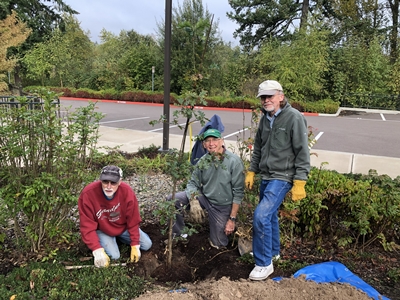Why Should the Church Care about Climate Change?
As people of God, we believe that we should be good stewards of the Earth that has been given to us. We sing that “This Is My Father’s World,” and we want that world to continue to flourish so that all creatures–and especially our children and grandchildren–can enjoy the beauty and the bounty of God’s gift to us. At St. Andrew, Earth Care is one of our Core Values.
Read Karen Klingelhafer’s meditation on Why Nature Matters.
Can the Soil Save Us?

Can the soil save us and the Earth we inhabit? Climate change has become more and more obvious over recent years as people around the globe are dealing with rising water in coastal cities, massive storms, longer and more devastating fire seasons, growing extinctions, and rising temperatures. Scientists agree that we are at the tipping point: We make some big changes now or we will all suffer even greater consequences to come.
Governments worldwide approach the problem from a top-down perspective that is both costly and quickly political. What steps can we as individuals take to tip the balance? Is it possible that we can sequester significantly more carbon in our suburban yards? See how it works in this short video.
Speaking about the massive imbalance in atmospheric carbon dioxide and other greenhouse gases, Carol Harker, co-chair of St. Andrew’s Yard Science Team, says, “We look at carbon as something bad when, in fact, we just have too much of it in the wrong form and the wrong place. Carbon is really one of life’s essential building blocks. The question is, ‘can we shift to a more harmonious balance with it?'”
Our Community Carbon Initiative

St. Andrew is participating in a new Carbon Community initiative introduced to us by EcoFaith Recovery. We are beginning to study the potential for urban yards to sequester carbon, thus helping to balance a system that has been thrown out of whack by the way we live. If you’d like to learn more or to join us in our study, please e-mail office@standrewlutheran.com. We have no time to waste!
If you prefer to jump in and explore the possibilities on your own, we recommend that you read The Soil Will Save Us, by Kristin Ohlson. The author not only explains the science of carbon, but also shares the hope and enthusiasm of many people around the world who are employing tactics to move carbon into the soil.
Since we began our journey of discovery and action in 2019, we have recognized how closely systems connect in our world. Production of plastic from fossil fuels threatens our oceans, we can use mason bees to augment pollination, each of us has a personal responsibility to each other and to our planet.
In our stewardship of the Earth, we commit to:
- Restoring the carbon balance in our atmosphere, soil, and seas by starting our efforts in our homes and yards;
- Taking personal responsibility for the choices we make and the way our lives impact other inhabitants of our world;
- Celebrating God’s gift of creation in worship.
- Spreading the word by educating others about their potential to make positive change for the planet; and
- Lobbying businesses, organizations, and government entities to enact practices and protections for our common environment.
Children’s Sermons about Oregon Natives
The Oregon White Oak, by Eric Luttrell
The Snowberry, by Carol Werner
The Indian Plum, by LuAnn Staul
The Oregon Grape, by Larry Bliesner
The Salmonberry, by Pat Christiansen
Planting Hope and Faith in the Reformation Earth Garden
On October 15, 2020 St. Andrew’s Outdoor Property Group gathered to plant two Oregon White Oaks on the north side of the Reformation Earth Garden. Hope settled into the soil easily, while the crew needed a pickaxe to loosen the ground where Faith would grow. The following photos recall that day:





At left, Eric Luttrell poses with Faith, the Oregon white oak that was planted as a keystone species in the Reformation Earth Garden. Both Hope and Faith will grow into large, canopy trees. Eventually they’ll become Grandparent Trees, providing sanctuary for a wide variety of caterpillars that themselves will feed baby birds in the area.
Hope and Faith in 2024



